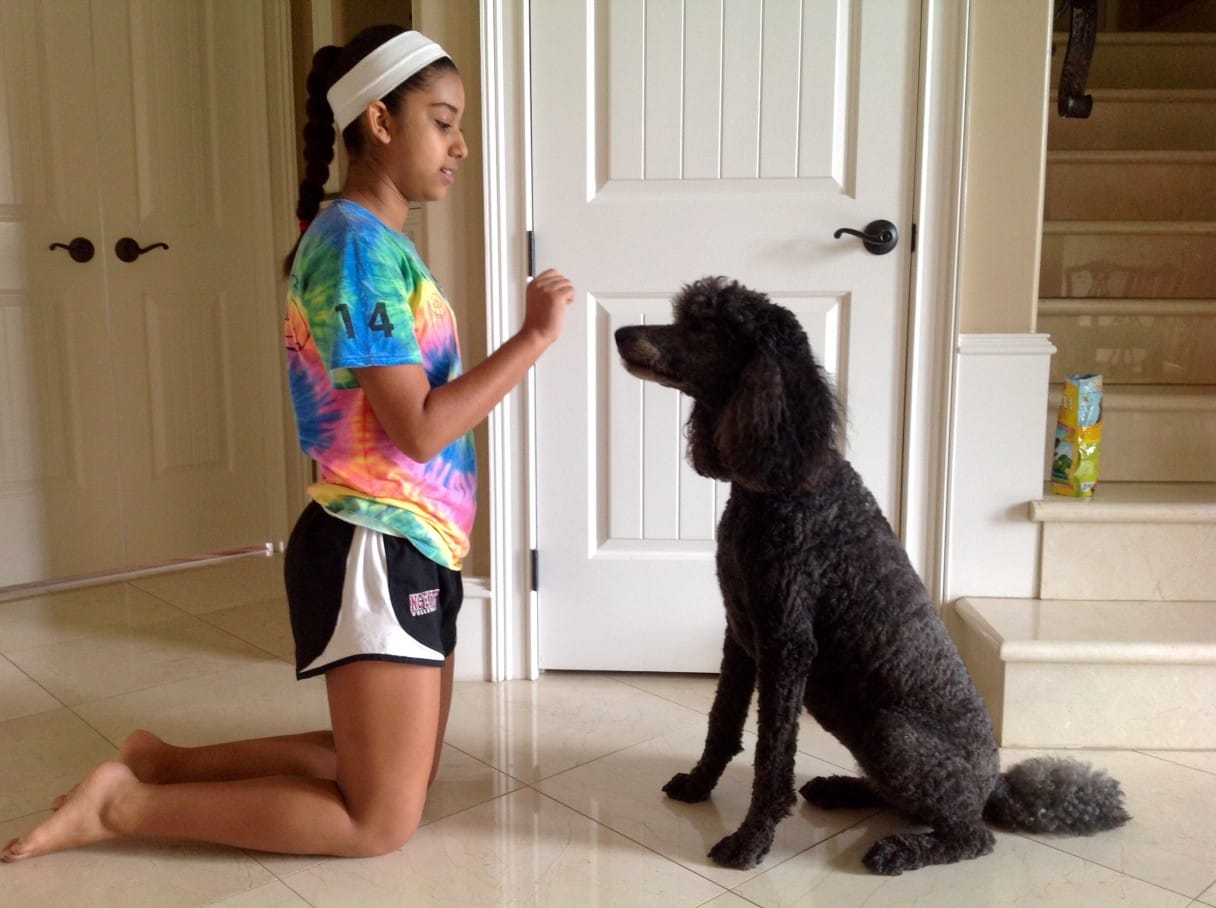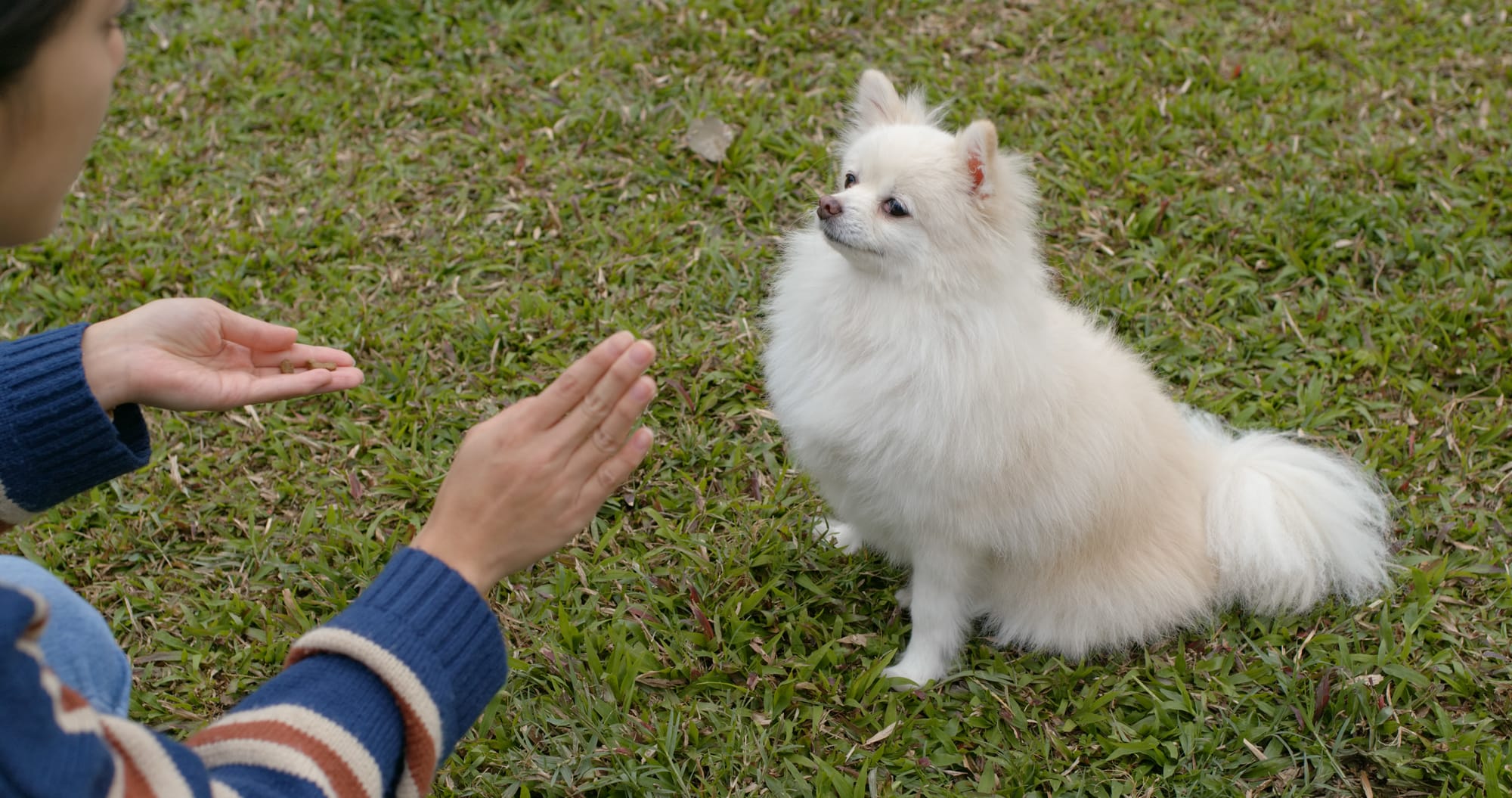Deafness in dogs is not an uncommon occurrence. According to the American Kennel Club, around 5% of dogs are born with a hearing impairment. While deafness can be a challenge for dogs and their owners, it is not an insurmountable obstacle. One way to communicate with deaf dogs is through sign language.

Sign language for dogs is not a new concept, but it has gained popularity in recent years as more people become aware of the benefits it can offer. In essence, sign language involves using visual cues to communicate with dogs instead of relying on auditory commands. This can be especially helpful for deaf dogs, who cannot hear their owner's voice. By using sign language, owners can give their dogs clear and concise commands that they can understand and follow.
Understanding Deaf Dogs
Causes of Deafness
Deafness in dogs can be caused by a variety of factors, including genetics, age, injury, and disease. Some breeds are more prone to deafness than others, such as the Dalmatian, Australian Cattle Dog, and English Cocker Spaniel. It is important to note that not all deafness is complete; some dogs may have partial hearing loss, which can make training and communication easier.

Behavior and Communication
Deaf dogs communicate differently than those who can hear. They rely heavily on body language and eye contact to understand and convey messages. It is important to be aware of a deaf dog's body language, as it can indicate their mood and intentions. For example, a stiff body and direct eye contact can signal aggression, while a relaxed body and a wagging tail can indicate playfulness.
Training a deaf dog requires patience and consistency. Positive reinforcement techniques, such as treats and praise, can be used to teach basic commands and tricks. Hand signals can also be used to communicate with a deaf dog, such as a thumbs up for "good job" or a hand wave for "come here".
It is important to keep a deaf dog safe, especially when out in public. They may not be able to hear approaching cars or other potential dangers. A leash and collar with identification tags should always be worn, and a fenced-in yard or secure area should be provided for outdoor playtime.
Overall, understanding deaf dogs requires a different approach to communication and training. With patience and consistency, deaf dogs can live happy and fulfilling lives with their human companions.
Basics of Sign Language for Deaf Dogs
Deaf dogs communicate through sign language, which involves using hand signals or hand signs to convey messages. This form of communication is essential for deaf dogs as they cannot hear verbal commands. In this section, we will discuss the basics of sign language for deaf dogs, including the difference between American Sign Language (ASL) and dog sign language, and creating a sign language vocabulary.
American Sign Language vs. Dog Sign Language
ASL is a complete language with its own grammar, syntax and vocabulary. It is used by the deaf community in the United States and Canada. Dog sign language, on the other hand, is a simplified version of ASL, designed specifically for dogs. It uses a smaller vocabulary and simpler hand signals that dogs can easily understand.
While ASL can be used to communicate with deaf dogs, it is important to note that dogs do not have the same cognitive abilities as humans. Therefore, dog sign language is more effective in communicating with deaf dogs.
Creating a Sign Language Vocabulary
Creating a sign language vocabulary for deaf dogs is an important part of communicating with them. It is essential to keep the vocabulary simple and consistent to avoid confusion. Here are some tips for creating a sign language vocabulary:
- Use simple hand signals that are easy for dogs to recognize
- Use consistent hand signals for each command
- Use positive reinforcement to encourage the dog to learn the hand signals
- Start with basic commands such as "sit," "stay," and "come"
- Gradually introduce new commands as the dog becomes more familiar with the vocabulary
In conclusion, sign language is an effective way to communicate with deaf dogs. Dog sign language is a simplified version of ASL, designed specifically for dogs. Creating a simple and consistent sign language vocabulary is essential to effectively communicate with deaf dogs.
Training Techniques

Getting Your Dog's Attention
Before training your deaf dog in sign language, it is important to establish a way to get their attention. One effective method is to use a small flashlight or laser pointer to create a visual cue. Simply shine the light near your dog's feet or body to get their attention, then proceed with the sign language commands.
Using Hand Signals and Cues
When training your deaf dog in sign language, it is important to use clear and consistent hand signals and cues. Start with basic commands such as "sit" and "stay," and gradually introduce more complex commands as your dog becomes more comfortable with the training.
It is also important to use positive reinforcement techniques such as treats and praise to encourage your dog's progress. Be patient and consistent in your training, and your dog will eventually learn to understand and respond to your sign language commands.
Incorporating Visual and Tactile Signals
In addition to hand signals, incorporating visual and tactile signals can also be helpful in training your deaf dog. For example, you can use a vibrating collar to create a tactile cue for your dog to pay attention. You can also use a flashing light or other visual cue to indicate when it is time to perform a specific command.
Overall, training a deaf dog in sign language requires patience, consistency, and creativity. By using a combination of hand signals, visual cues, and positive reinforcement techniques, you can effectively communicate with your furry friend and help them thrive in their environment.
Teaching Basic Commands
Teaching basic commands to deaf dogs is similar to teaching hearing dogs, but with a few modifications. It is important to use visual cues such as hand signals, body language, and facial expressions in addition to verbal commands to communicate effectively with deaf dogs.
Commands like 'Sit' and 'Stay'
Commands like "Sit" and "Stay" are essential for a well-trained dog. To teach the "Sit" command, the trainer can hold a treat above the dog's head and move it back towards the tail. This will cause the dog to sit down. The trainer can then give a thumbs up or a nod to reinforce the command. To teach the "Stay" command, the trainer can ask the dog to sit and then take a step back. If the dog stays in place, the trainer can give a thumbs up or a nod to reinforce the command.
Commands for Movement and Direction
Commands for movement and direction, such as "Come," "Spot," and "Right," are also important for deaf dogs. To teach the "Come" command, the trainer can wave their arms in a sweeping motion towards their body, indicating the dog to come towards them. For the "Spot" command, the trainer can point to the spot where the dog should go, and for the "Right" command, the trainer can point to the right with their right hand and fingers.
It is important to be consistent with hand signals and body language when teaching commands to deaf dogs. Using clear and concise signals will help the dog understand what is expected of them. With patience and consistency, deaf dogs can learn basic commands and become well-trained pets.
Positive Reinforcement and Rewards

Positive reinforcement and rewards are key elements in training deaf dogs to understand sign language. It is important to use these tools consistently and effectively to help the dog understand what is expected of them.
Using Treats and Rewards
Treats and rewards are a great way to motivate deaf dogs during training. Food rewards such as small pieces of chicken or cheese can be used to reinforce good behavior. It is important to use treats that are high-value to the dog and only give them as a reward for good behavior.
In addition to food rewards, verbal praise and physical affection can also be used as a reward. Dogs thrive on positive attention, so it is important to give them plenty of it when they do something right.
Clicker Training for Deaf Dogs
Clicker training is a popular method for teaching deaf dogs. Instead of using a verbal cue, a clicker is used to signal to the dog that they have done something right. The clicker is paired with a food reward, so the dog learns to associate the sound of the clicker with a positive outcome.
When using a clicker, it is important to start with simple commands and gradually work up to more complex ones. It is also important to be consistent with the timing of the click and the reward, so the dog understands what behavior is being rewarded.
Overall, using positive reinforcement and rewards is an effective way to train deaf dogs to understand sign language. By using high-value treats and clicker training, owners can help their dogs learn new commands and behaviors in a fun and engaging way.
Advanced Training and Activities
Obedience Training and Dog Sports
Once a deaf dog has mastered the basics of sign language, they can move on to more advanced training and activities. Obedience training can help them develop better focus and control, while dog sports can provide a fun and challenging outlet for their energy.
In obedience training, deaf dogs can learn to respond to a variety of commands, such as sit, stay, come, and heel. They can also be trained to perform more complex tasks, such as retrieving objects or navigating obstacle courses. Positive reinforcement techniques, such as treats and praise, can be used to reinforce good behavior and encourage learning.
Dog sports, such as agility, flyball, and obedience trials, can help deaf dogs develop their physical and mental abilities. These activities require the dog to follow a set of commands and complete a course or task within a certain time frame. They can also provide a fun and stimulating way for deaf dogs to bond with their owners and other dogs.
Training for Distance and Distractions
Deaf dogs may face additional challenges when it comes to training for distance and distractions. Without the ability to hear their owner's voice, they may have difficulty staying focused and following commands from a distance or in noisy environments.
To overcome these challenges, owners can use visual cues and hand signals to communicate with their deaf dogs. They can also gradually increase the distance and level of distraction during training sessions, starting with quiet and familiar environments and gradually working up to noisy and unfamiliar ones.
It's important to remember that deaf dogs may require more patience and repetition when it comes to training. However, with consistent and positive reinforcement, they can learn to overcome their hearing loss and become well-behaved and obedient companions. This is especially important for senior dogs, who may require more specialized training and care to maintain their physical and mental health.

Communication Beyond Hand Signals
Deaf dogs rely heavily on their sense of sight to communicate and understand their surroundings. While hand signals are an effective way to communicate with deaf dogs, there are other ways to convey information to them.
Facial Expressions and Body Language
Facial expressions and body language play a crucial role in communicating with deaf dogs. Dogs are great at reading body language and can easily pick up on cues such as a wagging tail or a relaxed posture. A simple smile or frown can convey a lot of information to a deaf dog. It is important for owners to be aware of their own body language and facial expressions when communicating with their deaf dog.
Using Leashes and Collars Effectively
Leashes and collars can also be used to communicate with deaf dogs. A bell attached to a collar can help a deaf dog locate their owner when they are out of sight. Tugging on a leash can also be used to get a deaf dog's attention and direct them where to go.
It is important to note that not all dogs respond well to leashes and collars. Some dogs may become anxious or fearful when restrained, so it is important to introduce these tools slowly and with positive reinforcement.
Overall, there are many ways to communicate with deaf dogs beyond hand signals. By using facial expressions, body language, leashes, and collars effectively, owners can effectively communicate with their furry friends.
Living with a Deaf Dog

Building a Strong Relationship
Living with a deaf dog can be a unique and rewarding experience. One of the most important aspects of living with a deaf dog is building a strong relationship with them. Since deaf dogs cannot hear verbal cues, it is important to use visual cues to communicate with them. This can include using hand signals, body language, and facial expressions. Consistency is key when communicating with a deaf dog, so it is important to establish a clear set of signals and use them consistently.
In addition to visual cues, it is important to establish a routine with your deaf dog. This can help them feel more comfortable and secure in their environment. It is also important to provide positive reinforcement for good behavior. This can include treats, toys, and praise. By building a strong relationship with your deaf dog, you can create a happy and fulfilling life together.
Safety Measures and Daily Routines
Living with a deaf dog also requires taking certain safety measures and establishing daily routines. Since deaf dogs cannot hear danger signals, it is important to keep them on a leash or in a secure area at all times. It is also important to make sure that your deaf dog is wearing identification tags at all times, in case they accidentally wander away.
Establishing a daily routine can also help your deaf dog feel more comfortable and secure. This can include feeding them at the same time each day, taking them for walks at the same time each day, and establishing a consistent bedtime routine. By establishing a routine, you can help your deaf dog feel more secure and less anxious.
Overall, living with a deaf dog can be a unique and rewarding experience. By building a strong relationship and establishing safety measures and daily routines, you can create a happy and fulfilling life with your deaf dog.
Adapting to Your Deaf Dog's Needs
Deaf dogs require some adjustments to their environment and communication methods to ensure they can live a happy and healthy life. Here are some tips on how to adapt to your deaf dog's needs:
Environmental Adjustments
One of the most important things you can do for your deaf dog is to make some adjustments to their environment. This can include:
- Visual cues: Use visual cues such as hand signals or flashing lights to get your dog's attention instead of verbal commands.
- Clear line of sight: Make sure your dog can see you when you are communicating with them. Avoid standing behind them or obstructing their view.
- Safe space: Create a safe space for your dog where they can retreat to if they feel overwhelmed or anxious. This can be a crate or a designated area in your home.
- Secure your home: Make sure your home is secure and your dog cannot escape. Deaf dogs may not hear cars or other dangers, so it's essential to keep them safe.

Support and Resources
There are many resources available to help you and your deaf dog. Here are some options:
- Training: Consider enrolling your dog in training classes specifically designed for deaf dogs. This can help you learn how to communicate effectively with your dog and teach them new commands.
- Online resources: There are many online resources available for deaf dog owners, including videos and articles on training techniques and communication methods.
- Support groups: Joining a support group for deaf dog owners can be helpful. You can connect with other owners, share tips and advice, and get emotional support.
By making some adjustments to your deaf dog's environment and utilizing available resources, you can ensure they have a happy and fulfilling life. Remember to be patient and consistent in your communication methods, and your deaf dog will thrive.

Conclusion
Sign language provides a lifeline for deaf dogs, enabling effective communication and strengthening the bond between owners and their pets. With patience, consistency, and the right techniques, teaching sign language can transform the lives of deaf dogs and their human companions.
Frequently Asked Questions (FAQs)
- What are the best hand signals to use for training deaf dogs?
- The best hand signals for training deaf dogs are those that are clear, distinct, and easy to remember. It is recommended to use simple hand signals that are different from each other, so that the dog can easily distinguish between them. Some commonly used hand signals include thumbs up for "good job," an open palm facing down for "stay," and a closed fist for "come."
- How can I teach my deaf dog sign language for basic commands?
- Teaching a deaf dog sign language for basic commands requires patience and consistency. It is recommended to start with basic commands such as "sit," "stay," and "come." Use a treat as a reward and repeat the sign consistently while giving the command. Over time, the dog will learn to associate the sign with the command.
- Are there any free resources available for learning sign language for deaf dogs?
- Yes, there are many free resources available for learning sign language for deaf dogs. Some popular resources include online videos, articles, and tutorials. It is important to ensure that the resource is reputable and provides accurate information.
- Which apps are recommended for teaching sign language to deaf dogs?
- There are several apps available for teaching sign language to deaf dogs, including "ASL American Sign Language," "Hand Talk," and "Signily." It is important to choose an app that is user-friendly and provides clear instructions.
- Where can I find printable hand signals to use with my deaf dog?
- Printable hand signals for use with deaf dogs can be found online through various websites and resources. It is important to ensure that the hand signals are clear and easy to understand.
- How do I effectively get the attention of a deaf dog during training?
- To effectively get the attention of a deaf dog during training, it is recommended to use visual cues such as waving a hand or stomping on the ground. It is also important to establish eye contact and use positive reinforcement such as treats and praise. Consistency and patience are key when training a deaf dog.